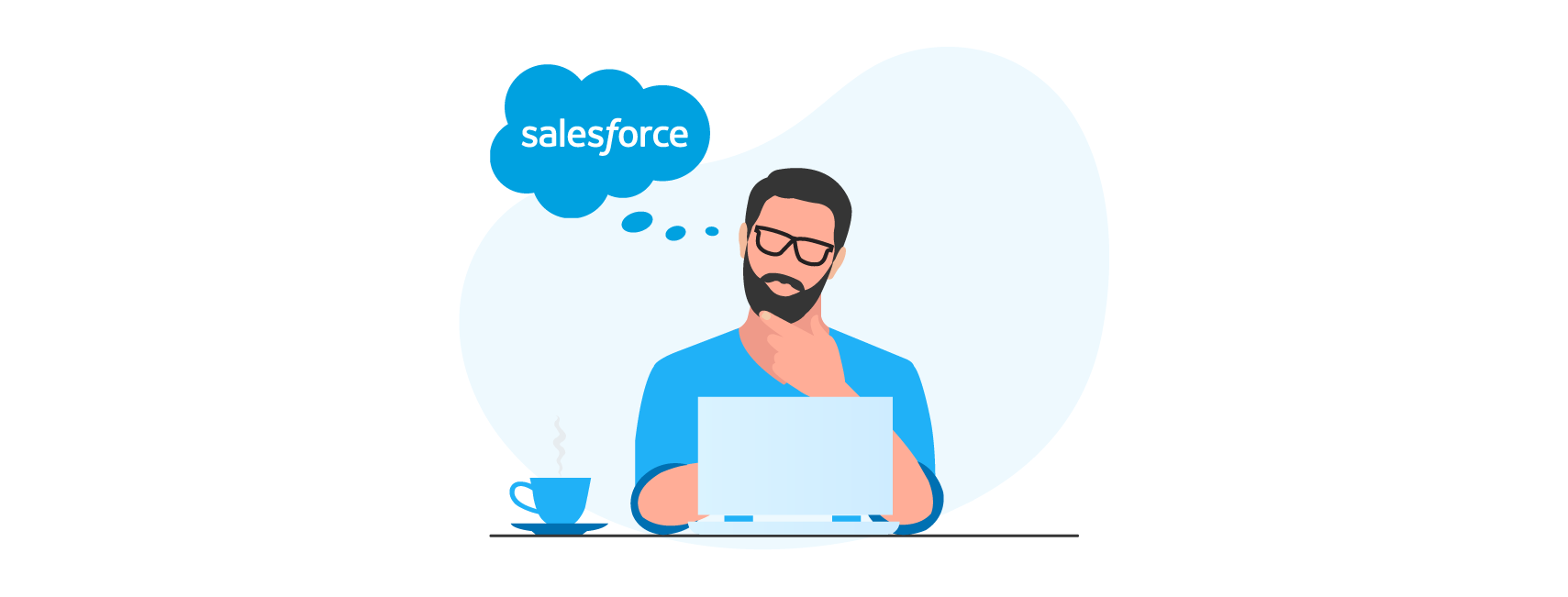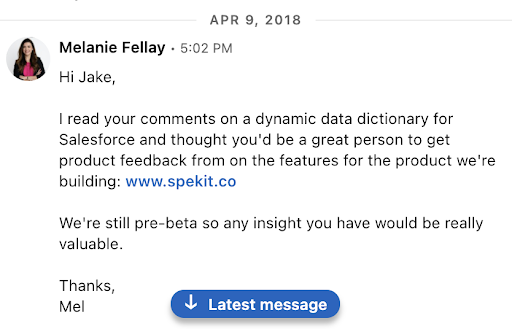I didn’t dream of becoming a CEO. Nor do I have a “typical-tech-founder,” Ivy-league dropout story. I went to college and started my career as a young professional in the real estate tech industry like a lot of millennials.
Although my trajectory as an accidental Salesforce admin reversing a failed Salesforce implementation to tech founder isn’t the traditional entrepreneurial path you might find in an MBA course, it’s a story born from the most basic need of having a problem and developing the solution yourself – and taking a giant leap of faith.
Without a blueprint to guide me, I can’t stress enough how important the Salesforce ecosystem was and is to my role as a founder and CEO. For anyone looking to transform an idea into a successful business, here are my top recommendations and some lessons I’ve learned along the way.
Behind the scenes: a challenging Salesforce implementation
I found my niche early in my career leading several operations teams at a tech start-up in the Bay area. Our company spent hundreds of thousands of dollars and an entire year trying to implement Salesforce, but our teams weren’t adopting it the way our leaders envisioned. They were about to throw in the towel altogether and build their own CRM when I asked to lead the task force and oversee the failed adoption.
I didn’t have a Salesforce background. Because I love to learn, I immersed myself in any and everything related to Salesforce to understand where we were failing. I watched videos, accessed Trailhead, read blog after blog (including Salesforce Ben) connected with Salesforce user groups, Googled the heck out of every question I had, and read Salesforce’s own documentation. I loved being an admin, but even with all of those resources at my disposal, I struggled to find a solution that simplified Salesforce onboarding and change management.
I hosted workshops and recorded webinars to train them on how to use Salesforce, but that wasn’t enough. I needed to get their buy-in and do whatever it takes to keep them in the tool itself. In other words, I believed that Salesforce adoption wouldn’t result from me merely showing them how to create an Opportunity. Instead, our reps needed access to their SOPs, sales training, competitor information, content and more within the tool itself so that they’d have no reason to leave their flow of work to find an answer.
Change management happened weekly, generating a constant flood of never-ending updates. Regardless of how well I communicated new information, there was no real way to track who received it or if they used it correctly. There had to be a better way.
I began researching LMS tools, digital adoption platforms and knowledge management solutions to find a product that would solve our adoption challenges. I soon discovered there wasn’t one-tool-to-rule-them-all, but rather, it would require a completely new type of platform that combined them all to achieve true digital enablement and give us the results we needed. With this realization, Spekit was born.


The Salesforce Ecosystem: My secret to early success
To help transition Spekit from an aha! moment to a functioning product, I took full advantage of the Salesforce ecosystem. In the early stages of ideation, I talked to any and everyone who would listen. I reached out to the Trailblazer community and joined as many user groups as I could. In fact, we ended up with two of our first customers from the first Dallas User Group I attended. When we barely had an MVP, I was graced by the presence of MVP Nana Gregg who took a big bet on us and became one of our loyal, candid and (I shouldn’t say this but it’s true, favourite..) customers.
I also browsed the Success Community to find other Salesforce admins who were challenged with the same problem and reached out to them to brainstorm and get their feedback on what the “ideal” solution would look like and learned… a LOT. I utilized the network to contact Salesforce solution architects like Amber Boaz, product leaders like Cheryl Feldman and Salesforce community MVPs like Eric Dreshfield. I polled them for ideas, opinions and found mutual pain points to discuss and gather feedback – showing them early mocks of our “data dictionary.” It was time-consuming but guess what, it worked! I not only received valuable insight on my product, but it also opened the door for future collaboration. (I even got an invitation to debut Spekit at a Midwest Dreamin event! – thanks Eric!).


Hard Lessons Make the Biggest Impact
These conversations proved to be invaluable. I developed Spekit initially thinking our data dictionary feature would simplify Salesforce implementations and improve overall adoption. After several rounds of testing, early demos and feedback sessions I learned a hard truth: A great idea doesn’t always translate into a sellable product.
While everyone agreed our data dictionary was valuable, it was too narrowly focused. Salesforce admins liked our product and how it allowed them to document their Salesforce org for the Salesforce team but admitted they wouldn’t need to use it every day and ultimately, it wasn’t a “must-have.” Did it solve a need? Sure. Was it the biggest reason that Salesforce adoptions fail? No.
Gulp. I swallowed my pride for a minute to re-evaluate what Spekit could offer. We used this feedback to get to the root problem we were trying to solve and transformed Spekit into a much broader solution – we had to be front and center for the end user.
Today, it’s a digital enablement platform with wider capabilities that go beyond our initial Salesforce documentation platform. We expanded our understanding of the problem from “let’s make it easy to document and show users how to use Salesforce” to “if we put everything an end user needs to learn and be productive in their roles exactly where they need it in Salesforce, they’ll have no reason to leave and thus adoption will inevitably be the result.” But in the early discovery phase, I can’t stress enough how important it is to be authentic and humble. These honest answers will drive your ability to create the best possible solution that can be the difference between acquiring customers and churning them.
Your buyers may not be who you think
As an ops person, I didn’t have a strong sales background. But as the co-founder of Spekit, I had to quickly become a sales rep and gained a new level of respect for those in the field.
I had naively assumed that Salesforce admins were my target persona due to my previous role, and spent demo after demo highlighting Spekit’s features without closing as many deals as I had hoped. Salesforce admins are great influencers who provided me with technical feedback and challenged me to think through what would work for their teams. They were (and still are) valuable internal resources who helped champion our cause. But depending on the company, they don’t always hold the purse strings, which can hinder sales.
To actually sell your solution, you must:
- Identify the budget holders, learn their pain points, and map your solution to their greatest needs.
- Articulate how you’ll solve their pain points and drive revenue, not just remove an inconvenience – no matter how painful that inconvenience is.
- Describe your implementation process to set the expectation of how you’ll work together and the support they’ll receive.
- Show how you’ll reduce cost, generate ROI (see this case study Salesforce did on us – ps. The Appexchange team is AWESOME), and positively impact their bottom line.
Simply put, it’s natural to want to highlight your product’s features, but it’s the value you provide that will close the deal.
Dreamforce was our dream come true
Once I felt Spekit was marketable, I couldn’t think of any better way to get it in front of so many potential customers and Salesforce users than Dreamforce. With only $150k in the bank, we spent $40k to attend. I knew it was a shot in the dark, and if it didn’t help us gain customers, we’d be in trouble. But I knew in my gut that we needed to get in front of as many teams as possible who use Salesforce to really validate the product.
Our first year generated 500 leads. It felt like incredible ROI. That is, until I realized how overwhelming it is to follow up with so many leads as a tiny sales team.
In our second year at Dreamforce, we changed strategies. Instead of getting caught up in the scanning frenzy, we only scanned those who actually saw Spekit or engaged in genuine conversation. Because our sales team was just myself (initially) and a few reps, it was far more manageable and productive to follow up with a list of contacts who were genuinely interested in our product. With this approach we landed another 30 out of our first 100 customers.
You may not see true ROI right away, but live events like Dreamforce are the best way to get product-market feedback, test your messaging, find your ideal customer, and generate quality leads in one place. Since we saw first-hand how expensive and big of a risk it is for small businesses, especially those founded by diverse founders with less access to capital, that same year we decided to pay it forward after raising our $2M seed round in September and created the Diversity at Dreamforce Scholarship to “donate” a booth to the next set of diverse founders to have a chance at launching there too.
Don’t be afraid to be yourself
In addition to developing Spekit’s brand and marketing it to everyone we could, I also spent quite a bit of time building my personal brand. Knowing people want to invest in and buy from authentic businesses with real people behind them, I had to give a face to my name. I used social media, wrote blogs and appeared in podcasts and interviews to pull the curtain back. I exposed my age, my vulnerability, my wins and losses and people began to take notice of our digital enablement platform.
Pro Tip: LinkedIn has become way more than an online resume. It’s an incredible professional social network and is now a tool of its own to generate leads, network and build your personal brand.
Like a lot of successful start-ups, we began to grow quickly. Unlike a lot of start-ups, I didn’t have millions of private funding to fuel the early days. My co-founder and I didn’t give ourselves a salary for 18 months. We downsized our apartments, moved in with family, and poured everything we had into launching Spekit.
Once we began to pursue our first real round of funding, I was thankful for all the time spent developing my personal and professional brand. It was much easier to reach out to investors, especially those in the Salesforce ecosystem, to try and raise capital with a strong brand beneath me.
That’s not to say it’s an easy process. If you’re in beginning the fundraising process, here are a few considerations:
- Don’t shy away from Salesforce users to narrow down your GTM strategy and product strategy. We initially thought Spekit would layer on top of other tools, so our early messaging was heavily focused around Salesforce.
- Determine why your idea is a billion-dollar one before making your pitch.Then, use irrational confidence to convince investors they’d be crazy to pass up your solution.
- Take the time to develop an answer for everything. Perfect your value prop; know your competitors, show how you’ll go to market and why you’re 10x better than everyone else. You may only get one chance to present your company.
- Fundraising is a two-way partnership. Yes, you want their investment, but they’ll also be your partner, coaches, mentors. Don’t take money from just anyone, because your relationship will be ongoing.
- Get super clear on your WHY as a company – it’s just as critical as your product itself and write it down (here’s an example of mine)
The Salesforce Jackpot
IDC forecasts that using Salesforce’s cloud services and those of its ecosystem will create up to $1.56 trillion in revenues and 9.3 million new jobs by 2026. The economic impact of this incredible organization extends beyond job creation, with IDC also estimating that for every $1 Salesforce makes, the ecosystem will make $6.19. With this in mind, it should come as no surprise that we purposely built a company that pairs our technology with the Salesforce platform to ensure we stay ahead of the curve and innovate at the same rate as one of the most powerful tech companies in the world.
Today, we’ve raised $15 million in funding and are just one example of ISVs who benefited from the Salesforce community. I truly believe we hit the jackpot by having this incredible ecosystem to support us every step of the way. Starting a business is scary but when you’re passionate, it’s worth every bit of heartache. Whether you’re an entrepreneur, developer, well-established admin or want to become an accidental CEO like me, there’s no better place than the Salesforce community to help you launch your business.
PS. If you have an idea and want to brainstorm, I’m always open to sharing feedback. Find me on Linkedin.

Comments: